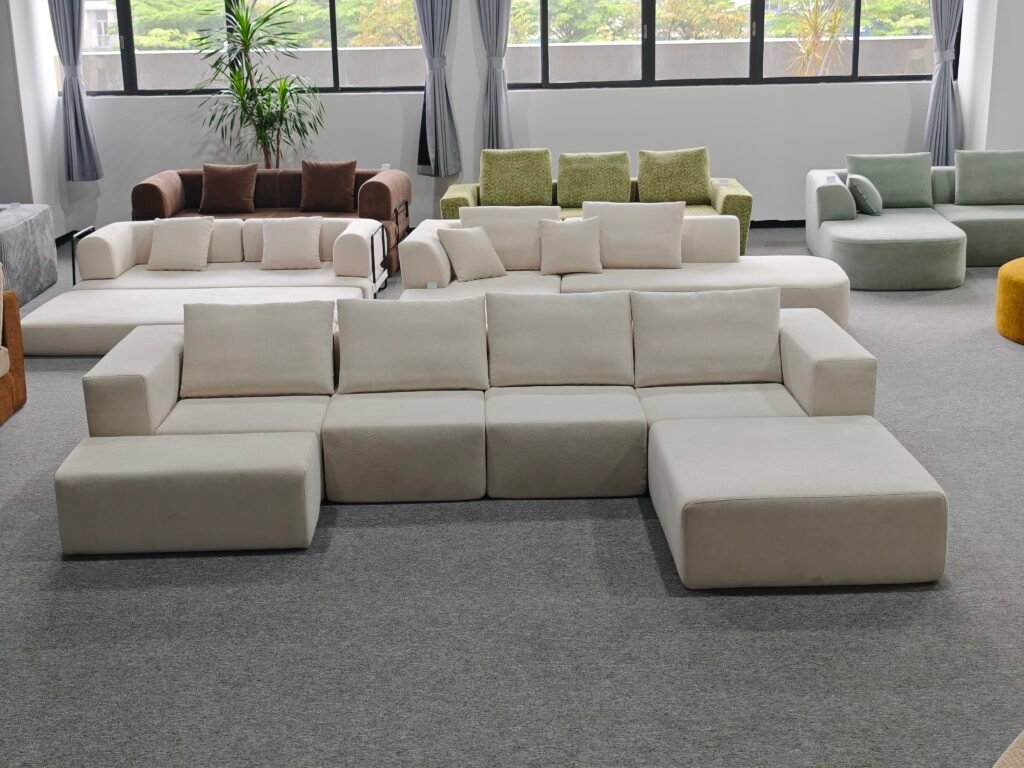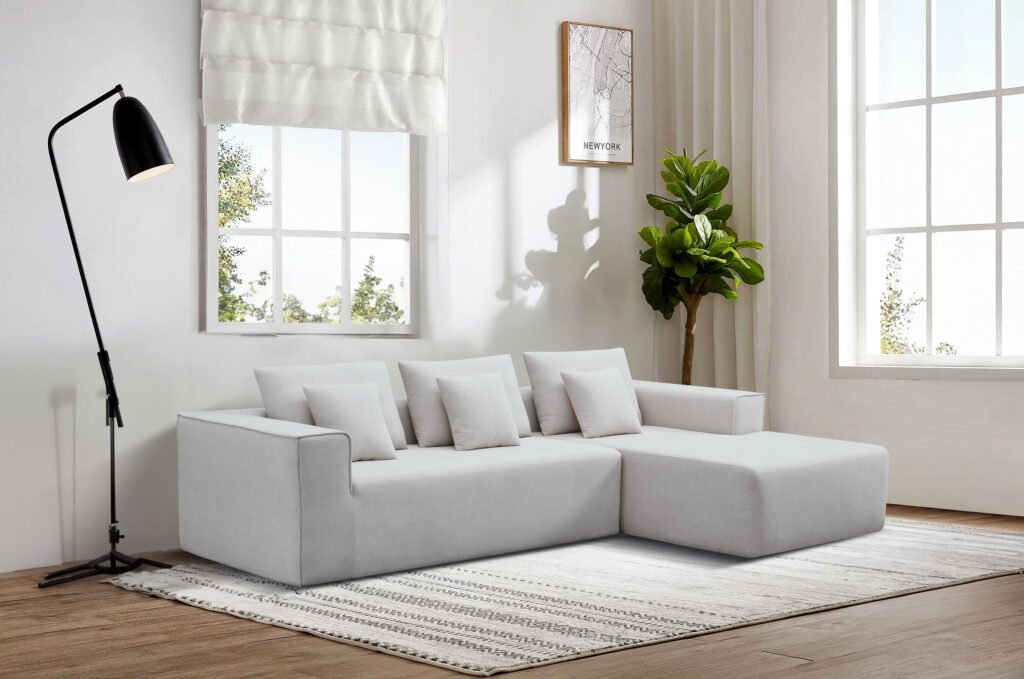The furniture industry has experienced significant innovation in recent years, with compressed sofas becoming a hallmark of modern logistics, design, and sustainability. These products, expertly manufactured and shipped by leading compressed sofa factories such as modular-sofas.com, leverage vacuum compression technology to reduce bulky furniture volumes by as much as 65%. This process drastically optimizes shipping and storage costs while maintaining product quality and comfort.
Once a compressed sofa reaches the end user and the packaging is removed, a certain challenge often arises: what to do with the unused compress sofa wraps? These consist primarily of multi-layer vacuum films and reinforced corrugated cardboard cartons designed for durability, moisture resistance, and structural strength. Although these packaging materials are built to protect and compress the sofa during transport, they often become redundant post-unpacking and may be discarded as waste if no plan is in place for their reuse or recycling.
Recognizing the quality and environmental value embodied in these materials, this comprehensive guide explores numerous innovative and practical approaches to reusing unused compress sofa wraps effectively. These solutions not only contribute toward waste reduction and circular economy principles but can also create operational savings and inspire sustainability-minded branding for businesses.
By introducing 15 smart reuse ideas accompanied by a clear comparison table, this article encourages furniture manufacturers, retailers, logistics providers, and consumers alike to rethink and repurpose compress sofa packaging in ways that align with contemporary environmental standards and commercial needs.


Materials Behind Compressed Sofa Wraps: Composition and Properties
The packaging for compressed sofas typically involves two principal materials each with unique physical characteristics and reuse potentials.
The first is the vacuum film wrap, usually comprising multi-layer polyethylene (PE) or polyamide (PA) laminates engineered for high tensile strength, flexibility, and moisture resistance. These films can endure the enormous mechanical pressure of vacuum compression, plus subsequent handling stresses during storage and international shipping. They are thicker and more robust than standard plastic films, capable of being depressurized and reused multiple times if handled carefully.
The second material is the reinforced corrugated cardboard carton, often constructed from double or triple wall board with laminated surfaces to enhance moisture protection and prevent deformation. These cartons provide critical structural integrity during container stacking, preventing crushing or damage. Their durability proves valuable beyond initial shipping when repurposed thoughtfully.
A responsible compressed sofa factory like modular-sofas.com underscores sustainability by employing recyclable vacuum films, responsibly sourced cardboard certified to ISO 9001 standards, and minimizing excess packaging. This commitment establishes a valuable foundation for secondary use or recycling of packaging materials, extending their life cycle beyond initial utility.
Innovative and Practical Reuse Options for Compress Sofa Wraps
Unused vacuum films and cardboard cartons present a diverse palette of reuse opportunities that can benefit households, commerce, and industrial users while enforcing environmental stewardship. Examining these options in detail provides actionable insights for effective materials recovery.
One compelling use of vacuum film wraps is repurposing them as protective storage bags for bulky and lightweight items alike. Their airtight sealing property allows for compact, dust- and moisture-resistant storage of comforters, blankets, winter clothing, or even spare sofa cushions. Families, storage facilities, and furniture warehouses can compress these items repeatedly, reducing storage footprints without additional investment in specialized fabric bags or plastic storage containers.
Extending this idea, vacuum films can be fashioned into do-it-yourself vacuum storage bags with minimal tools and materials. By sealing the edges using a heat gun or strong adhesive tape, leaving an opening just large enough for a vacuum cleaner hose, users can expel air, significantly lowering volume for clothing, textiles, or linens. This approach empowers movers, residents in limited space apartments, and seasonal wardrobe organizers to maximize available space while reusing packaging sustainably.
Vacuum films paired with reinforced cardboard pieces excel as improvised shipping padding and protective materials. Retailers and e-commerce sellers often need cost-effective internal packaging to cushion fragile goods. Sheets of the vacuum film can be wrapped around items, and cardboard cutouts can support or separate packages, reducing reliance on commercial bubble wrap or polystyrene foam. This reuse not only creates circular material usage but also controls packaging expenses.
Of particular interest to garden enthusiasts, flattened corrugated cardboard sheets make excellent biodegradable weed barriers when placed beneath mulch or soil. They block sunlight, inhibiting weed growth effectively, and eventually decompose to enrich the soil. The cardboard from compressed sofa cartons is especially well suited for this task due to its thickness and durability, providing gardeners and landscaping services a sustainable alternative to synthetic mats.


Further emphasizing outdoors and home improvement contexts, vacuum films and cardboard cartons serve as temporary floor and surface protectors. During renovations, painting, or flooring installation, these materials help insulate surfaces from dust, paint splatter, and scratches. Contractors, DIY homeowners, and renovation teams benefit from the ease of deployment and disposal or recycling afterward.
The strong cardboard material can also be reworked into shipping box reinforcements or direct reuse. Cutting and repurposing sofa cartons to buttress fragile shipments or create entirely new parcels reduces packaging costs and waste. This is especially attractive to logistics firms and wholesale distributors who regularly ship volume-sensitive goods.
Another creative avenue lies in pet care applications, where vacuum films combined with sturdy cardboard can provide lightweight, custom pet beds or play areas. Lined with insulating padding or old fabrics, such beds offer washable, portable resting spots or containment zones, ideal for pet owners or animal shelters aiming to reduce material costs.
In workshops or garages, cardboard sheets from compress sofa packaging can be transformed into organizers, drawer dividers, or shelf liners. These inexpensive crafting materials help hobbyists or tradespeople systematize tool arrangements or parts storage with tailored cardboard inserts that are easily replaced or recycled after wear.
Their accessibility and light weight make vacuum films and cardboard ideal for children’s art and school projects. These materials form great canvases for painting, model making, or structural crafts. Schools, parents, and community centers looking for affordable, recyclable craft media find this reuse both economical and environmentally conscious.
Outdoor furniture and seasonal equipment protection is another practical reuse scenario. Wrapping items with vacuum film creates effective weather-resistant covers against rain, dust, or pests during off-seasons or storage. Homeowners and landscape services benefit from this approach as a low-cost solution to extend outdoor furniture life.
Vacuum films can also serve as heavy-duty recyclable waste or recycling bags in commercial or household settings. Their thickness and strength outperform standard plastic bags in some cases, supporting heavier loads and being reusable several times before recycling. Managing waste streams this way helps reduce single-use plastic consumption.
Thanks to their water- and wind-resistant properties, vacuum films transform well into emergency rain ponchos or windbreakers. Outdoors enthusiasts or emergency planners can cut and seal them into disposable protective garments for short-term use in adverse weather circumstances.
A notable industrial-use idea combines cardboard and vacuum film as insulation liners. In cold storage or shipping, layered cardboard and films provide lightweight, low-cost thermal buffers that help maintain temperatures. Food retailers and cold-chain logistics providers can find these improvised liners a helpful addition to existing packaging.
Finally, collecting unused wraps and donating or selling them to upcycling programs, artisans, or educational institutions encourages circular economic principles. Providing raw materials to craft schools, maker spaces, and NGOs supports creativity, local economies, and environmental stewardship on a broader scale.
Evaluating Reuse Ideas: A Comparison Table
| Reuse Idea | Vacuum Film | Cardboard | Durability | Ease of Implementation | Environmental Benefit | Suitable For Business or Household | Complexity |
|---|---|---|---|---|---|---|---|
| Protective Storage Bags | Yes | No | High | Easy | High | Both | Easy |
| DIY Vacuum Storage Bags | Yes | No | Medium | Moderate | High | Movers, Households | Moderate |
| Shipping Padding and Protection | Yes | Yes | Medium | Moderate | Medium | Retailers, Logistics | Moderate |
| Gardening Weed Barrier | No | Yes | High | Easy | High | Gardeners | Easy |
| Temporary Floor and Surface Covers | Yes | Yes | Medium | Easy | Medium | Contractors, DIYers | Easy |
| Shipping Box Reinforcement/Reuse | No | Yes | High | Easy | High | Logistics, Retail | Easy |
| Pet Beds and Play Areas | Yes | Yes | Medium | Moderate | Medium | Pet Owners | Moderate |
| Workshop Organizers | No | Yes | Medium | Moderate | Medium | Hobbyists, Workshops | Moderate |
| Children's Arts and School Projects | Yes | Yes | Medium | Easy | Medium | Schools, Parents | Easy |
| Outdoor Furniture Covers | Yes | No | Medium | Easy | Medium | Homeowners | Easy |
| Heavy-Duty Waste/Recycle Bags | Yes | No | Medium | Easy | Medium | Warehouses, Commercial Facilities | Easy |
| Emergency Ponchos and Windbreakers | Yes | No | Low | Moderate | Medium | Outdoor Enthusiasts | Moderate |
| Cold Storage Insulation Liners | Yes | Yes | Medium | Moderate | Medium | Cold-Chain Logistics | Moderate |
| Donation for Upcycling | Yes | Yes | Medium | Easy | High | Art Communities, NGOs | Easy |
Environmental and Business Advantages of Repurposing Packaging
Implementing reuse strategies for compress sofa wraps yields substantial environmental and economic dividends. Environmentally, this translates into lowered volume of landfill waste, reduction of resource extraction for new packaging materials, and diminished carbon emissions from manufacturing, transportation, and waste processing. By keeping packaging in use longer, businesses contribute directly to circular economy principles — a key tenet in today’s global sustainability frameworks and corporate social responsibility mandates.
From a business perspective, reusing these materials reduces recurring costs associated with purchasing specialized packaging or storage solutions. It also minimizes waste disposal expenses and mitigates exposure to increasingly strict environmental regulations and taxes. Moreover, a commitment to sustainable packaging reuse enhances brand image and customer loyalty, especially among eco-conscious demographics.
Factories like modular-sofas.com that pioneer compressed sofa technology reinforce their market leadership by innovating in packaging sustainability and supporting their business partners with guidance and education on responsible wrap reuse and disposal.
Best Practices for Managing Unused Compressed Sofa Wraps
To maximize benefits from compress sofa wrap reuse, businesses should adopt well-structured handling and management protocols. These may include designated collection zones near unpacking areas to prevent contamination and damage, staff training to ensure careful sorting and storage, and collaborations with local recycling partners or artisan groups for materials in excess.
Keeping accurate records of usage, savings, and environmental impact furthers stakeholder engagement and transparency in sustainability reporting. Encouraging employee participation and innovation in reuse ideas can foster a culture of ecological responsibility and operational excellence.
The strategic integration of reuse initiatives into corporate procurement, logistics, and waste management processes ensures that these valuable materials achieve their full potential before recycling or disposal.


Closing Thoughts
Unused compress sofa wraps, encompassing durable vacuum films and reinforced cardboard cartons, are much more than just packaging waste. They represent an opportunity to integrate environmental consciousness with practical resourcefulness across residential, commercial, and industrial settings.
Through the fifteen smart ideas outlined above—ranging from protective storage, shipping solutions, and gardening to educational crafts and emergency uses—users can actively contribute to waste reduction while unlocking value from materials that would otherwise be discarded.
Engaging with a forward-thinking compressed sofa factory like modular-sofas.com allows businesses and consumers to embrace packaging innovations that reflect quality, environment, and sustainability. Implementing proactive reuse programs aligned with these ideas enhances profitability, customer satisfaction, and positive environmental impact.
Should you require further guidance tailored to your unique operational context—whether detailed tutorials on creating vacuum storage bags, case studies on wrap reuse in logistics, or assistance designing corporate recycling initiatives—expert advice from modular-sofas.com and this article’s insights are ready to support your success.